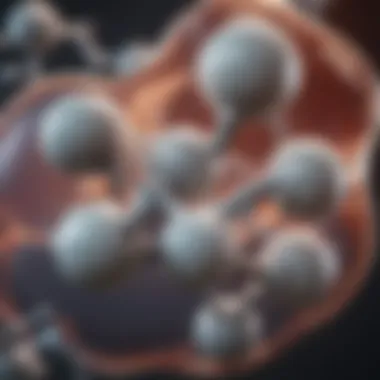A Comprehensive Overview of N-Acetyl Cysteine


Intro
N-Acetyl Cysteine (NAC) is a compound that has garnered attention in both scientific literature and health discussions. It plays an essential role not only as a supplement but also as a precursor to the amino acid cysteine and, subsequently, to the powerful antioxidant glutathione. This article seeks to unpack the various dimensions of NAC, exploring its biochemical significance, therapeutic applications, and over-the-counter availability.
Research Overview
Summary of Key Findings
NAC has shown promise in several health conditions. Research highlights its potential benefits in respiratory diseases, psychiatric disorders, and even in managing certain effects of chronic illnesses. Studies often focus on its role in replenishing glutathione levels in the body, which is significant for combating oxidative stress and supporting overall cellular function. Furthermore, meta-analyses and systematic reviews suggest a favorable safety profile when used appropriately.
Importance of the Research
Understanding NAC’s mechanisms and benefits is critical for both clinicians and patients. As more people turn to supplements for health improvement, comprehension of these compounds becomes increasingly relevant. NAC's availability over the counter raises questions regarding dosage, efficacy, and potential interactions with other medications. Gaining insight into research can guide individuals in making informed decisions about their health.
Therapeutic Applications
NAC is widely recognized for its medical applications. Some key areas where NAC has been assessed include:
- Respiratory health: NAC is often utilized in managing conditions like chronic obstructive pulmonary disease (COPD) and bronchitis, helping to reduce mucus viscosity.
- Mental health: Emerging evidence suggests that NAC may aid in conditions such as bipolar disorder and schizophrenia, where oxidative stress plays a role.
- Detoxification support: It acts as an antidote for acetaminophen overdose, illustrating its importance in acute care settings.
Over-the-Counter Availability
Regulatory Landscape
NAC can be purchased without a prescription in many regions, though scrutiny regarding its status has increased. The FDA’s stance and its regulatory implications are vital points for consumers. Keeping abreast of these changes helps individuals understand what is available and how to use these supplements safely.
Formulation Variability
NAC is available in various forms—capsules, tablets, and powders, each catering to different preferences. Understanding these options is important for health consumers. Some may prefer capsules for convenience, while others might opt for powders to mix into drinks or food.
The End
The narrative around N-Acetyl Cysteine encapsulates broader themes of health and wellness. As research evolves, NAC remains a focal point for those looking to enhance their health through supplements. Staying informed about its benefits, applications, and availability will empower individuals in their health journey.
Understanding N-Acetyl Cysteine
N-Acetyl Cysteine (NAC) is not just a supplement. It signifies a complex biochemical agent with various roles in health and well-being. This section focuses on key aspects of NAC, exploring its importance in biochemical functions, therapeutic applications, and implications for health.
NAC is often recognized for its pivotal role as a precursor to glutathione, one of the body’s most powerful antioxidants. By boosting levels of glutathione, NAC helps mitigate oxidative stress and may reduce the risk of chronic diseases. Beyond its antioxidant abilities, NAC's components are fundamental to detoxification processes, particularly in the liver, where it aids in the breakdown of harmful substances.
Moreover, NAC has gained traction in mental health domains. Studies connect it to potential mood stabilization, particularly in conditions like depression and obsessive-compulsive disorder. Besides that, its anti-inflammatory properties make it an appealing option for researchers interested in respiratory health and inflammation.
Understanding the multifaceted nature of NAC is essential, especially considering its growing popularity as an over-the-counter supplement. However, users must consider proper dosages and possible interactions when including NAC in their health regimens. Thus, comprehending its chemical composition and historical context becomes vital.
Chemical Composition and Structure
N-Acetyl Cysteine is a modified version of the amino acid cysteine. Its molecular formula is C5H9NO3S. The structure contains a thiol group, which is significant for its ability to donate electrons. This property enhances its effectiveness as an antioxidant.
The acetyl group attached to cysteine contributes to its solubility in water, making NAC easily absorbable when ingested. The presence of nitrogen in its composition also allows NAC to play a role in various biochemical reactions across the body. Overall, its structure allows NAC to engage in antioxidant activities, which is crucial for cellular health.
Historical Background


The story of N-Acetyl Cysteine began in the 1960s when it was first used primarily in the medical field as a mucolytic agent. Hospitals prescribed NAC to patients suffering from respiratory conditions to help clear mucus from the airways. As research expanded, scientists began to uncover its potential beyond respiratory health.
In the 1980s, NAC gained recognition for its role in medical treatments. It became well-known as an antidote for acetaminophen overdose, an application that remains prominent today. The understanding of NAC's antioxidant properties further propelled research into its use in various health conditions, including cardiovascular and mental health. Presently, NAC is available as an over-the-counter supplement, widely accessible to a general audience, paralleling the increasing interest in holistic health approaches.
"Understanding the chemical structure and historical use of NAC provides essential background as to why it remains relevant in contemporary health discussions."
In summary, the knowledge of N-Acetyl Cysteine, alongside its chemical makeup and rich historical background, lays the foundation for a deeper dive into its biochemical impact and therapeutic implications.
Biochemical Mechanisms of N-Acetyl Cysteine
N-Acetyl cysteine, commonly referred to as NAC, plays a crucial role in numerous metabolic pathways within the body. Understanding the biochemical mechanisms of NAC is essential for recognizing its potential benefits and therapeutic applications. This section elaborates on how NAC functions, specifically focusing on its role as a precursor to glutathione and its notable antioxidant properties.
Role as a Precursor to Glutathione
Glutathione is one of the body's most vital antioxidants. It is composed of three amino acids: cysteine, glutamine, and glycine. NAC serves as a vital precursor for synthesizing glutathione due to its high cysteine content. Cysteine itself is a sulfur-containing amino acid that is not abundant in the diet, making NAC supplementation particularly beneficial.
The synthesis of glutathione requires a sufficient supply of cysteine. NAC provides this by getting converted into cysteine in the body, thus stimulating glutathione production. The significance of this process extends to various health implications, especially in conditions where oxidative stress is prevalent. Higher levels of glutathione contribute to cellular protection against damage caused by free radicals and toxins, which are often linked to various diseases, including neurodegenerative disorders and cardiovascular diseases.
In short, NAC's role in glutathione synthesis is central to its effectiveness as a therapeutic agent, especially as it helps in maintaining optimal antioxidant levels within cells. This mechanism sheds light on why NAC is often recommended for detoxification and managing conditions characterized by oxidative stress.
Antioxidant Properties
NAC exhibits impressive antioxidant properties. As described earlier, NAC boosts glutathione levels, enhancing the body’s ability to neutralize free radicals. This property is particularly relevant in the context of various diseases that involve oxidative stress, such as asthma, chronic obstructive pulmonary disease, and even certain types of cancer.
NAC has been shown to reduce inflammation and improve symptoms in patients with conditions like chronic bronchitis.
In addition to directly increasing glutathione levels, NAC may also scavenge free radicals on its own. This dual action makes NAC an essential compound in supporting cellular health and protecting against external insults. Its impact on cellular health can be examined during exposure to toxins or during periods of increased oxidative stress, including while recovering from illness or injury.
Moreover, studies suggest that NAC can enhance the efficacy of other antioxidants, creating a synergistic effect that provides better overall protection. Therefore, employing NAC as a supplement could prove beneficial in clinical and non-clinical settings, where oxidative damage is a concern.
Therapeutic Applications of N-Acetyl Cysteine
N-Acetyl Cysteine plays a significant role in various therapeutic applications. This section elaborates on its utility and implications in different health areas. Its potential benefits are becoming increasingly popular among healthcare providers and researchers alike. Understanding these applications helps in recognizing the vital function N-acetyl cysteine can serve in health management.
Respiratory Health
Chronic Obstructive Pulmonary Disease
Chronic Obstructive Pulmonary Disease, often known as COPD, represents a major cause of morbidity and mortality, impacting millions worldwide. It includes chronic bronchitis and emphysema, which lead to significant airflow limitation. N-Acetyl Cysteine can aid in alleviating the symptoms related to COPD by thinning mucus for easier expulsion. The mucolytic property is a key characteristic that distinguishes NAC as a beneficial option.
The unique feature of NAC is its ability to increase Glutathione levels in the lungs. This is advantageous as Glutathione acts as a powerful antioxidant, potentially reducing oxidative stress and inflammation in the airways. However, while NAC is well-received in clinical settings, it is not a standalone solution for COPD and should be integrated thoughtfully into comprehensive treatment plans.
Asthma Management
Asthma is a chronic respiratory condition characterized by inflammation and narrowing of the air passages. N-Acetyl Cysteine may help in asthma management by acting as an antioxidant and reducing airway inflammation. This ability makes NAC a relevant choice to consider.
One noteworthy aspect of NAC in asthma treatment is its potential to improve lung function. By decreasing mucus viscosity, it allows easier breathing, particularly in individuals struggling with frequent exacerbations. The ideal approach involves using NAC alongside traditional asthma medications. While NAC is promising, further research is required to fully ascertain its efficacy in diverse asthma populations.
Mental Health Considerations
Depression
Depression is a prevalent mental health disorder affecting many individuals, often leading to debilitating symptoms. Recent studies suggest that N-Acetyl Cysteine can influence neurotransmitter modulation, particularly glutamate, which has a role in mood regulation. This specific property makes NAC a noteworthy candidate in the realm of mood disorder treatments.


The unique feature of NAC is its capacity to provide an adjunctive treatment option. Combining NAC with standard antidepressants could yield better outcomes. However, care must be taken, as NAC's effectiveness can vary among patients, and it should not replace traditional treatments.
Obsessive-Compulsive Disorder
Obsessive-Compulsive Disorder (OCD) is characterized by intrusive thoughts and compulsive behaviors. N-Acetyl Cysteine has been studied for its potential role in reducing the severity of obsessive-compulsive symptoms. Its mechanism could involve modulating glutamate levels, similar to its role in depression.
The key characteristic of NAC in treating OCD is its potential to act as an adjunct therapy. It may improve treatment adherence while augmenting overall outcomes. Nonetheless, more extensive studies are necessary to solidify NAC's role within comprehensive OCD treatment frameworks.
Detoxification Processes
Detoxification is essential for maintaining health, especially regarding the liver and other organs responsible for processing and excreting toxins. N-Acetyl Cysteine contributes positively to these processes due to its high cysteine content, which enhances glutathione synthesis. Higher glutathione levels facilitate the elimination of harmful substances more effectively. This feature of NAC as a detoxifying agent positions it as an integral part of discussions surrounding overall wellness and integrative health strategies.
Cardiovascular Health
Cardiovascular diseases continue to be a leading cause of death globally. N-Acetyl Cysteine may offer protective effects on cardiovascular health by reducing oxidative stress and improving endothelial function. The mechanism involves enhancing nitric oxide levels, which favors healthy blood vessel function. This characteristic positions NAC as a beneficial supplement for cardiovascular health.
Regulatory Status of N-Acetyl Cysteine as an OTC Product
The regulatory status of N-Acetyl Cysteine (NAC) is a crucial aspect within the broader context of its popularity as a supplement. Understanding how NAC is classified by regulatory bodies can influence its availability and consumer acceptance. This section aims to elucidate the complexities of NAC’s status as an over-the-counter (OTC) product, particularly in regions like the United States.
An important consideration is that NAC has been recognized for various therapeutic applications, ranging from respiratory health to mental wellness. Its classification affects how consumers access this supplement and the degree of oversight it receives in quality and safety. As a widely researched compound, the implications of its regulatory status are significant for both healthcare professionals and consumers alike.
FDA Classification
The Food and Drug Administration (FDA) plays a pivotal role in determining the market status of supplements, including N-Acetyl Cysteine. NAC is categorized primarily as a dietary supplement. This classification means it must comply with specific safety and labeling requirements but does not necessitate pre-market approval. Here are some essential points to consider about the FDA classification of NAC:
- Dietary Supplement Status: As a dietary supplement, NAC does not require rigorous testing before being marketed.
- Safety and Labeling: While the FDA does not verify efficacy, it mandates that dietary supplements be safe and correctly labeled.
- Regulatory Changes: Recent discussions within the FDA have sparked debate about potentially reevaluating NAC’s classification, which may alter its future availability.
It is worth noting that NAC is often recognized for its mucolytic properties and antioxidant capacity. As it has gained popularity, concerns about quality control and product consistency may arise. Thus, adhering to safety regulations is essential.
Comparative Analysis with Prescription Drugs
When considering N-Acetyl Cysteine in relation to prescription medications, it’s essential to recognize some key differences and similarities that arise. NAC is often used as a treatment for specific conditions, such as acetaminophen overdose; however, its OTC status underscores a different regulatory approach. Here are some notable comparisons:
- Access: Unlike prescription medications, NAC can be accessible to a broader audience without a healthcare provider’s approval. This increases its availability but may raise concerns over self-diagnosis and usage.
- Regulatory Scrutiny: Prescription drugs undergo significant testing and monitoring, ensuring safety and efficacy. In contrast, NAC, as a supplement, lacks such stringent oversight, which can lead to variability in product quality across brands.
- Potential Risks: While NAC has beneficial properties, misuse, or unregulated consumption can lead to side effects, including gastrointestinal discomfort. This highlights the need for consumer awareness about correct dosages and potential interactions with other medications.
"As NAC's availability remains a point of discussion, its classification and the ramifications of new regulation could fundamentally change its landscape in healthcare and consumer use."
In summary, the regulatory status of N-Acetyl Cysteine significantly shapes its accessibility and the confidence consumers can have in its use. Understanding these regulatory dynamics is crucial for maximizing the benefits of NAC while mitigating potential risks. Through ongoing research and dialogue with regulatory bodies, the true potential and safety of N-Acetyl Cysteine can be fully realized.
Availability of N-Acetyl Cysteine Over-the-Counter
The availability of N-Acetyl Cysteine (NAC) over-the-counter is an imperative aspect discussed in this article. It highlights how easy access to NAC can benefit various populations, including students, researchers, and health professionals. This straightforward availability may encourage informed discussions about the biochemical properties and therapeutic applications of NAC, ultimately fostering a better understanding of its role in health and well-being.
NAC is an essential compound, known for its role as a precursor to glutathione, an important antioxidant in the body. As a supplement, it may contribute to health in areas such as respiratory conditions, mental health, and detoxification processes. Therefore, its easy access allows individuals to explore these benefits without extensive barriers, leading to practical health applications in daily life.
Key considerations surrounding the over-the-counter status of NAC include:
- User Convenience: No prescription is needed, simplifying the purchasing process.
- Widespread Availability: NAC can typically be found in various retail formats from local pharmacies to online marketplaces.
- Informed Choices: Easier access encourages consumers to investigate its health benefits.
In concluding this section, the implications of NAC as an over-the-counter product are significant and multifaceted, offering users a straightforward means to integrate it into their supplement routines. This availability invites further inquiry into its efficacy and safety across various scenarios.


Efficacy and Safety of N-Acetyl Cysteine
The efficacy and safety of N-acetyl cysteine (NAC) is crucial to understanding its role in health. This section examines existing research that supports its benefits, as well as potential risks associated with its use. Given the increasing popularity of NAC as a supplement, evaluating these parameters can help potential users and healthcare providers make informed decisions.
Review of Existing Research
Numerous studies have investigated the effectiveness of N-acetyl cysteine in various health contexts. NAC is well recognized for its role as a precursor to glutathione, a major antioxidant in the human body. Research has consistently shown that NAC supplementation can significantly boost glutathione levels. For instance, a randomized controlled trial in Free Radical Biology and Medicine indicated that NAC improved oxidative stress markers and supported liver function in patients with chronic liver diseases.
In addition to its antioxidant properties, NAC has shown promise in respiratory health. A meta-analysis published in Respiratory Medicine reviewed several studies and concluded that NAC can reduce the frequency and severity of exacerbations in chronic obstructive pulmonary disease (COPD) patients. Moreover, its potential in mental health is emerging. A study in Journal of Clinical Psychiatry found that NAC could be beneficial in treating symptoms of depression and obsessive-compulsive disorder, showing a statistically significant reduction in symptom severity across a participant group.
Despite these positive outcomes, the efficacy of NAC varies widely among individuals and specific health conditions. The importance of further research is emphasized to establish clear guidelines on dosage and therapeutic uses.
Potential Side Effects
While NAC is generally regarded as safe, there are some considerations to take into account regarding its side effects. Most users tolerate NAC well, but some may experience mild adverse reactions. Common side effects include gastrointestinal issues such as nausea, vomiting, and diarrhea. These symptoms often diminish as the body adjusts to the supplement.
Additionally, NAC can interact with certain medications. For example, it may affect the absorption and effectiveness of certain antibiotics or nitroglycerin, which is used for chest pain. Caution is advised for individuals on such medications.
There are also rare but serious allergic reactions reported in some individuals. Symptoms can include swelling, difficulty breathing, and hives. If anyone experiences these symptoms after taking NAC, they should seek medical attention immediately.
Overall, it is important to consult with a healthcare provider before starting NAC supplementation, particularly for individuals with pre-existing health conditions or those on other medications.
"Existing research highlights the antioxidant and therapeutic potential of N-acetyl cysteine, yet thorough individual assessments are necessary to ensure safety and effectiveness."
In summary, while the research supports the efficacy of N-acetyl cysteine in several health contexts, attention to potential side effects and individual health status is critical. Further studies will help elucidate the full range of NAC's benefits and establish its optimal use in clinical practice.
The Future of N-Acetyl Cysteine in Research
As the understanding of health and nutrition evolves, N-acetyl cysteine continues to gain traction in various research areas. This is essential not only for enhancing foundational knowledge but also for potential application in clinical settings. Future research could reveal more uses for NAC, making it a vital component in therapeutic regimens. The potential impact on public health could be significant, particularly in disease prevention and health maintenance.
Emerging Studies
Ongoing studies focus on several promising areas. Research is looking into NAC's role in mood disorders, where its influence on neurotransmitter systems might provide insights for treating conditions like depression and anxiety. For instance, one study indicated that NAC may restore glutathione levels, a factor linked to reducing oxidative stress in neurological disorders. Alongside mental health, other studies target its effects on aging and metabolic disorders, which may lead to breakthroughs in how we approach chronic disease management.
Moreover, researchers are examining NAC’s anti-inflammatory properties. This could open pathways for treatment strategies, particularly in respiratory diseases, such as asthma or chronic obstructive pulmonary disease. The scope of NAC research is ever-expanding, which underlines the necessity for diligent scientific inquiry.
Implications for Public Health
The implications of research on N-acetyl cysteine could be far-reaching. If ongoing studies confirm its efficacy for various conditions, NAC could become a widely accepted part of preventative health strategies. This might shift dietary supplement paradigms towards more scientifically grounded recommendations.
Furthermore, understanding how NAC interacts with other treatments can inform how healthcare professionals recommend it. For instance, its potential synergy with other antioxidants or anti-inflammatory agents could enhance treatment protocols.
Important considerations must also be noted. As NAC becomes popular, ensuring safety and establishing evidence-based guidelines will be vital. This is crucial for both practitioners and patients to avoid misconceptions about its uses.
Finale
The conclusion section of this article serves as a critical synthesis of the various insights surrounding N-Acetyl Cysteine (NAC). Understanding its biochemical mechanisms, therapeutic potential, and regulatory status is essential for both healthcare professionals and individuals interested in optimizing their health. This compound has garnered considerable attention not only due to its antioxidative properties but also its role in supporting respiratory health, mental health, and detoxification processes.
Summarizing Key Points
- Chemical Composition and Structure: NAC is a modified form of the amino acid cysteine, which contributes to its unique characteristics and benefits.
- Biochemical Mechanisms: Its function as a precursor to glutathione highlights its role in combating oxidative stress.
- Therapeutic Applications: NAC shows promise in various health domains, including respiratory and mental health, supporting its use in clinical settings.
- Regulatory Status: Recognized by the FDA, NAC is available over-the-counter, although regulatory changes could impact its accessibility.
- Safety and Efficacy: Ongoing research continues to evaluate its safety profile, underscoring the necessity for informed use.
"N-Acetyl Cysteine plays a pivotal role in antioxidant defense mechanisms, which could transform approaches to various health issues."
Call for Further Research
Despite the substantial body of evidence supporting NAC's benefits, there remains a need for further investigation. Future studies should explore:
- Longitudinal Effects: Understanding the long-term effects of NAC supplementation on health outcomes.
- Dosage and Administration: Analyzing the most effective dosage regimens for different populations.
- Comparative Studies: Evaluating NAC against other antioxidants to determine relative efficacy and safety.
- Mechanistic Insights: Expanding on the biochemical pathways influenced by NAC for potential novel applications.



